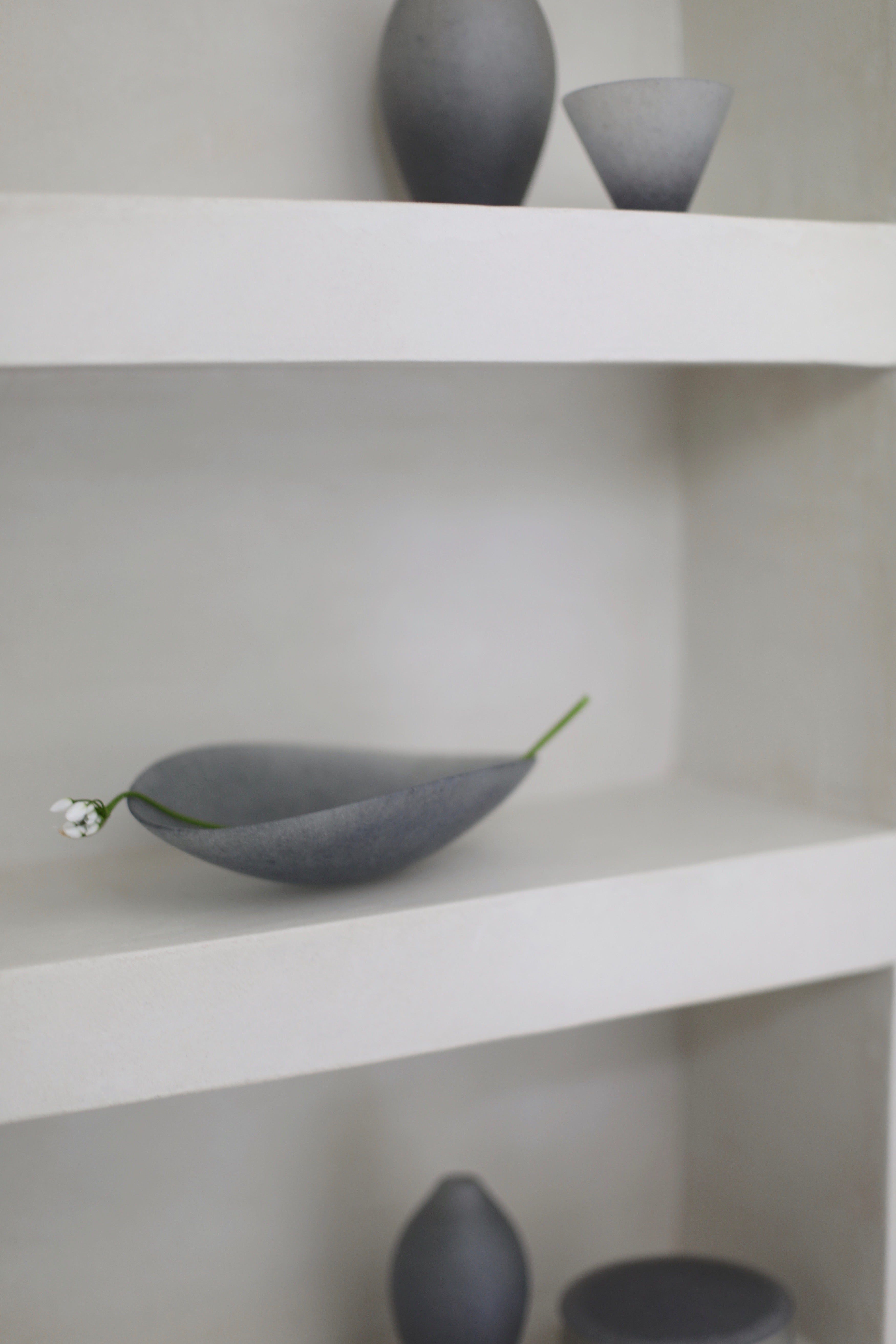Vital to the development of Japanese ceramics were the beliefs and skills that arrived from China, via Korea, between the 3rd and 7th centuries: the potter’s wheel, Buddhism, and advanced techniques including three-colour lead glazes and high-temperature firing in kilns. When Japan became a warrior society in 1185, and Zen Buddhism brought meditation and intuition to the fore, simple austere forms replaced colourful ceramics. Natural-ash glazes were used in the Kamakura and Muromachi periods (1185-1573), and storage pots and jars were developed, including the “tsubo”, a strong traditional form that Yoko Komae continues to explore in her work. Famous at that time were the Shigaraki kilns near Kyoto, one of the “Six Old Kilns”, the others being Tamba, Bizen, Tokoname, Echizen and the Seto kiln, which developed various glazes: ash brown, iron black, feldspar white, and copper green. The importance of establishing outstanding lineages continues today, and can be seen in a modern sense in the beautiful work of Kenta Anzai.
 It is the ritual of tea however – the “chanoyu” ceremony created by the 16th-century tea master Sen no Rikyu, embodying Zen values that are also expressed in flower arrangement and calligraphy – that exerted the biggest influence on the story of Japanese ceramics. Pared-down tea jars, tea bowls, water jars and small food vessels (inspired by Korean domestic ware) were produced in Kyoto by Chojiro, whose son was given the “raku” (pleasure) seal by the Shogun. The family is still producing Raku ware today. With a “deep stillness” and small enough to fit into the hand, Raku chawan (tea bowls) are hand-shaped, glazed, low-fired, and removed from the kiln while still hot, to create an imperfect texture that embodies the ideals of wabi-sabi – a philosophy that remains present in some of the work exhibited here.
It is the ritual of tea however – the “chanoyu” ceremony created by the 16th-century tea master Sen no Rikyu, embodying Zen values that are also expressed in flower arrangement and calligraphy – that exerted the biggest influence on the story of Japanese ceramics. Pared-down tea jars, tea bowls, water jars and small food vessels (inspired by Korean domestic ware) were produced in Kyoto by Chojiro, whose son was given the “raku” (pleasure) seal by the Shogun. The family is still producing Raku ware today. With a “deep stillness” and small enough to fit into the hand, Raku chawan (tea bowls) are hand-shaped, glazed, low-fired, and removed from the kiln while still hot, to create an imperfect texture that embodies the ideals of wabi-sabi – a philosophy that remains present in some of the work exhibited here.
Even today, when the pace of urban living and technology is accelerating at high speed, and the emphasis in society is on achieving “perfection”, the ancient threads remain strong in contemporary Japanese ceramics, fulfilling what is perhaps a universal need: for simple, quiet, “imperfect” objects that are close to nature and embody the touch of a human hand, giving us a direct and tangible connection to the skills, thoughts and soul of the artist who created it. In Akiko Hirae’s textures, Yoko Komae’s “unbalanced” forms, Kaori Tatebayashi’s quiet simplicity, and Shinobu Hashimoto’s dark and subtle luminosity, it still seems possible to touch these ancient shadows, but in a very modern way.

The long, isolated and artistically rich Edo period (1603-1868) created many forms of ceramics, from muted tea wares with patterns or motifs from nature, to colourful porcelain. The blue-and-white technique, which had come from China, was further developed in Akita, becoming popular for food dishes and cups. The influence of this blue-and-white tradition can still be seen in the colourful miniature work of Yuta Segawa, who looks to old Chinese and Japanese pots for inspiration, and sometimes collaborates with a painter.
When Japan opened its doors to the West in the Meiji era (1869-1912), a passion for “japonisme” began. In 1911, Bernard Leach was invited to a raku party in Tokyo. He later recounted: “I was carried away to a new world … seized with the desire to take up the craft.” Leach went on to develop his own style based on traditional Japanese, Chinese, Korean and English slipware, setting up a studio in St Ives, Cornwall, with his life-long friend Shoji Hamada. Hamada belonged to the Mingei modern craft movement in Japan that sought to keep Japanese folk traditions alive, using ancient methods to create modern works. He was one of a number of outstanding potters in the 20th century who became recognised as “mukei bunkazai” (“living cultural treasures”), for both honouring and reinventing old techniques.
Today, Japan’s ceramic traditions and concept of beauty, which resonate throughout the world among lovers of design, persist in earth-toned tea-ware that is made in the same spirit of muted, poetic simplicity, and vases, cups and other containers that express the wabi-sabi acceptance of ageing and imperfection, inspired by nature. At the same time, there is a spirit of free and playful experimentation in contemporary Japanese ceramics, which is open to other influences too, including the interaction of Japanese and British traditions as initiated by Bernard Leach. This freedom is particularly notable in the work of artists such as Mizuyo Yamashita who were born in Japan but have moved to London, to study and set up studios here. Their influences are diverse, from ancient Egypt to contemporary Western art.
Each of the artists presented in Form & Surface has found a unique form of expression, experimenting with clays, textures, colours, firing, glazes, time, light and shadow, to form works that possess the empathetic traces of human touch and thought in the making process, and encompass a spirit that is both ancient and modern, timeless and of one moment in time.
Author: Clare Farrow for Maud & Mabel












